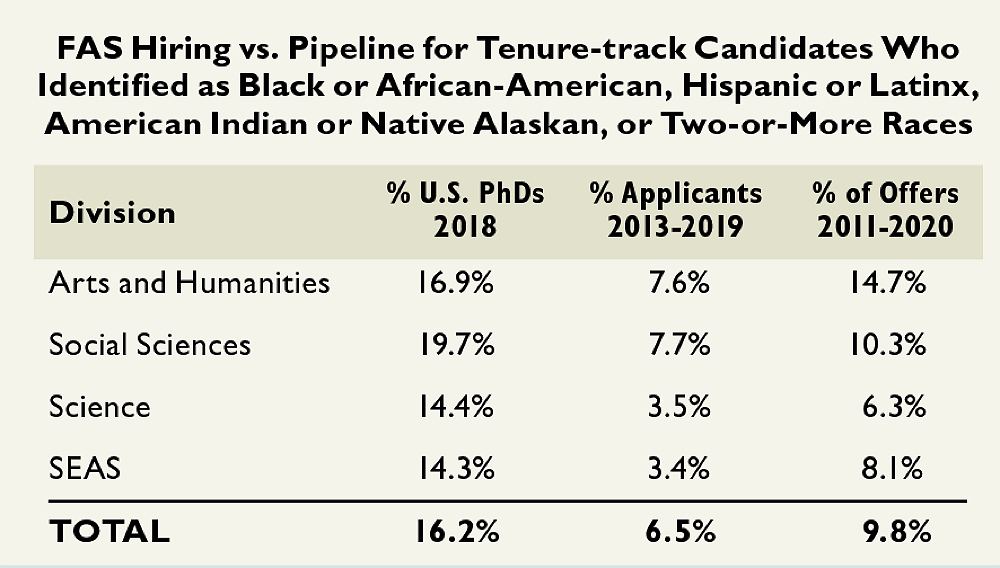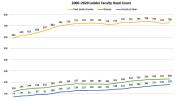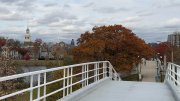Data on the faculty’s composition, embedded within Faculty of Arts and Sciences (FAS) dean Claudine Gay’s annual report, are largely consistent with prior-year trends.
The ladder faculty (tenured and tenure-track) numbers 728, up from 724; that is down from a 2017 peak (739), but the total has generally been between been 720 and 730 since 2008, when the Great Recession took hold. (The faculty’s ranks grew steadily from 592 in 2000 until the recession, and then plateaued.) Of the 728 ladder-faculty members, 230 are women (up from 227 in 2019, and nearly double the 119 two decades earlier), and 179 are faculty of color (up from 176 last year, more than doubling the 71 in 2000.) Thus, 32 percent of ladder faculty are women, and 46 percent of tenure-track faculty; faculty members of color are 25 percent of the ladder faculty and 36 percent of the tenure-track ranks.
But during the November 3 faculty meeting, Nina Zipser, dean for faculty affairs and planning, cited several challenges as FAS seeks to assure that it can identify, attract, and develop the most talented professors. For all the progress in appointing faculty of color, the ladder faculty remains 75.4 percent white, 14.6 percent Asian, and just 10.0 percent underrepresented minorities or two-plus races.
The tenure-track ranks are more diverse—but 568 of 728 ladder-faculty members are tenured, and such positions turn over slowly. And the faculty itself is barely growing. Most searches are frozen now, given pandemic-induced financial strains, but even during the relatively flush post-Harvard Campaign years, the number of ladder-faculty offers declined from 229 during the period 2011 through 2015, to 196 in the next half-decade.

That means each search must be as broadly based as possible to assure FAS is tapping the full range of talent. But the condensed data Zipser presented from the report showed FAS attracting dramatically less diverse applicant pools for tenure-track positions, compared to the pipeline of available Ph.D.’s. In 2018, 16.2 percent of U.S. doctorates went to people who identified as underrepresented minorities—but only 6.5 percent of FAS tenure-track applicants from 2012 to 2019 so identified. The data for the offers FAS extended are slightly more favorable (9.8 percent identified as underepresented minorities), but in general, Zipser’s report characterized the outcome as “significantly underrepresenting the Ph.D. pipeline” in searching for potential professors of the future.
Zipser told the faculty meeting that FAS’s searches for tenured positions were more broadly based—evidence that in considering these higher-stakes appointments, faculty members do more carefully curated, thorough, comprehensive searches. That suggests more attention and effort would improve tenure-track searches, too. Zipser suggested the latter suffer from a certain passivity: the assumption that because Harvard announces a search, a broad, diverse pool of candidates will somehow self-assemble. The evidence says otherwise, and Zipser, associate dean of diversity, inclusion, and belonging Sheree Ohen, and a new group of three faculty members acting as advisers, will work with FAS colleagues to promote more active, encompassing searches for all openings.
Zipser’s office subsequently made available the 2020 distribution of ladder-faculty members by FAS academic division: arts and humanities, 195 (unchanged from the prior year); social science, 238 (down from 243); science, 207 (up from 197); and engineering and applied sciences, 88 (down from 89). In the faculty’s relatively steady state, these cohorts are largely consistent with the gradual evolution in the past dozen years toward slightly smaller arts and humanities and social-science cohorts, a slightly larger group of scientists, and a steadily enlarging engineering and applied sciences population. Growth in this last cohort has likely been constrained by space limitations (to be relieved with the opening of the Allston facility this winter; see page 13), and by the fierce competition among universities to hire computer scientists and other specialists who are in high demand in academia and industry.
For further information, see harvardmag.com/covid-fas-finances-20.









